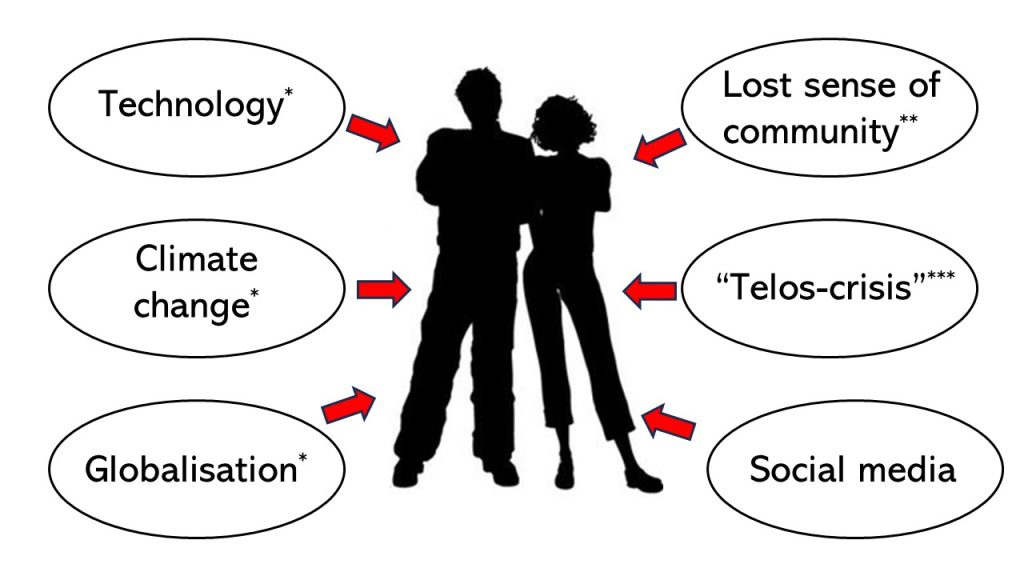Personal experience and logic both suggest to me that adolescence has, most probably, always been a time of angst. Young people have the awareness to understand the challenges in the world around them (and, often, a capacity to imagine the worst), but do not yet have the experience or autonomy to be able to do much to control their circumstances (or feelings). No doubt every era has had its own peculiar challenges, but some probably more than others. Imagine how difficult and anxiety-inducing it must have been to be a teenager during the Great Depression, for example, or during the Cold War.
Just recently I read “The Diary of a Young Girl”, by Anne Frank. This precociously talented girl wrote with extraordinary detail and honesty of her experiences as part of a Jewish family, hiding from the Nazis in Amsterdam during the second World War. She wrote –
Anyone who claims the older ones have a more difficult time here certainly doesn’t realise to what extent our problems weigh down on us, problems for which we are probably much too young, but which thrust themselves upon us continually, until, after a long time, we think we’ve found a solution, but the solution doesn’t seem able to resist the facts which reduce it to nothing. That’s the difficulty in these times: ideals, dreams and cherished hopes rise within us, only to meet the horrible truth and be shattered.
Even though, for most young people, the world has always been a difficult place in which to grow up, I suggest that the current generation of adolescents are facing a unique combination of challenges to their wellbeing. We live, and teach, in times of unprecedented change – an “age of disruption”, according to Hannon & Peterson (2021). The acronym VUCA, originally applied in military contexts but now widely employed in the world of business, refers to the volatility, uncertainty, complexity and ambiguity that have become characteristic of life in the 21st century (Lawrence, 2013). Thomas Friedman (in Thank You for Being Late,2016) described this present era as an “Age of accelerations” and identified three realms in which change is occurring at an exponential rate: Information Communications Technology; climate change, and globalisation.
I have developed a figure which adds three additional stressors experienced by young people in 2024 to those identified by Friedman.

Sebastian Junger (Tribe, 2016) described another stressor when he proposed that “we have lost our sense of community”. Junger went on to suggest that the chronic loneliness experienced by many moderns in Western societies may be contributing to “some of the highest rates of depression, schizophrenia, poor health and anxiety in history”. This loneliness epidemic (likely exacerbated in many instances by the COVID-19 pandemic), poses a real threat to wellbeing if, as Brené Brown (2018) suggested, “Connection, along with love and belonging, is why we are here, and it is what gives purpose and meaning to our lives”.
Another (perhaps related) change, was described by Simon Smart (2016) when he suggested that biblical Christianity has been replaced as the dominant worldview in Western societies over the past two or three centuries. Now, other worldviews dominate, most of which exclude transcendence, eternal hope and everlasting virtues. This situation was described by David Brooks (in The Second Mountain, 2019) as a “telos-crisis”, where telos refers to having a moral purpose or ultimate aim.
Then, of course, the present generation (described as iGen by Jean Twenge, 2017) are the first cohort to ever only know a life in which they can be connected 24 hours a day to their peers (if they choose), by means of the internet and social media. As any parent will attest, this capacity for perpetual connectedness is often accompanied with a variety of undesirable pressures.
In the light of this combination of stressors, is it any wonder that many students in Australian secondary schools are not well beings? Rather, our young people are facing extraordinarily high levels of mental health concerns. The World Health Organisation (2021) reported that “mental health conditions account for 16% of the global burden of disease and injury in people aged 10-19 years”. Further, Mission Australia (Carlisle, et al., 2018) reported that this is a growing problem, with the number of young people who identify mental health as an important issue in Australia increasing from 20.6% in 2016 to 43% in 2018. This was also supported by the Headspace Youth Mental Survey (2020), which found that 34% of Australian young people self-describe their levels of psychological distress as “high” or “very high”.
What then, as school leaders and teachers, should we do in response? I believe the first step is one of recognition – of both the problem and the opportunity we have in schools to be part of the solution. Schools play a significant role in the lives of children, not only in terms of academic achievement but also as contributors to the students’ social-emotional, physical, and mental wellbeing.
I suggest that, more than ever, schools need to recognise the importance of a holistic education. In its simplest form, holistic education is defined as “concerned with educating the whole person – body, mind and soul – to develop his or her fullest potential” (Lee, 2015). In some ways, holistic education may be seen as a “return to basics”, when we recognise that holistic education is a lot like the paideia of first-century Greece, a term used to describe the process of becoming fully human.
Increasingly, holistic education is expressed through an emphasis on character development, in schools that have a vision to teach “children to become good people and good students at the same time” (Garber, 2014, p. 162). Garber cautioned us to “beware the temptation to believe that competence can be separated from character, that excellence can be defined in merely academic terms, without a corresponding concern for the kind of people we are” (p. 48). Or, as Angela Duckworth (cited by Seligman, 2011, p. 103) put it – “Character is at least as important as intellect”.
A focus on student wellbeing is important in contemporary schools, even those that would not claim to offer a holistic education, not least because of the link that has been established between wellbeing and academic achievement. (Dix, et al., 2020; Cardenas, et al., 2022). More than that, a recent report by the Australian Institute for Teaching and School Leadership (AITSL) identified the importance of “choosing the right wellbeing program [as well as] measuring its impact and effectiveness” (AITSL, 2022, p. 4).
Although it has been the subject of study for hundreds of years, wellbeing has proven to be difficult to define. I like to think of wellbeing as “flourishing”, with a range of positive factors needing to be present to meet this description. Huppert & So (2013) equated flourishing with “life going well”. Their definition of flourishing was limited, however, to a state of mental good health or psychological wellbeing. I prefer the more holistic definition offered by Wolbert et al (2015), as “the actualisation of the human potential … a person functioning at optimal level”. I also love the description of flourishing students offered by Lynne Swanner and Andy Wolfe (Flourishing Together, 2021), as “exuberant in their learning and … growing socially, emotionally, physically and spiritually”.
School leaders and pastoral carers, I have a challenge for you: Ask yourselves the following questions –
- Is the education your school provides truly holistic? That is, does it attend to the needs of the whole child – body, mind and soul?
- Does your school have an effective student wellbeing framework?
- Are the priorities of your school appropriate for the times in which we live (this “Age of accelerations”)?



